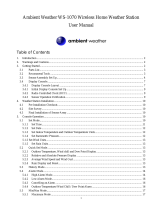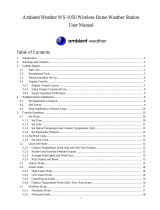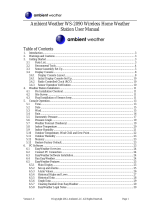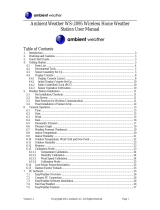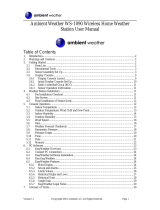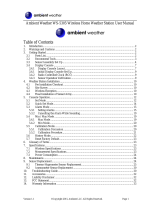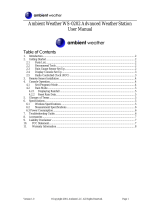Page is loading ...

Version 2.4 ©Copyright 2015, Ambient LLC. All Rights Reserved. Page 1
Ambient Weather WS-2080A Wireless Home Weather
Station User Manual
Table of Contents
1. Introduction ..................................................................................................................................... 3
2. Warnings and Cautions ................................................................................................................... 3
3. Quick Start Guide ............................................................................................................................ 3
4. Getting Started ................................................................................................................................ 3
4.1 Parts List ................................................................................................................................. 4
4.2 Recommend Tools .................................................................................................................. 5
4.3 Sensor Assembly Set Up ........................................................................................................ 5
4.4 Display Console ................................................................................................................... 14
4.4.1 Display Console Layout ................................................................................................... 14
4.4.1 Initial Display Console Set Up ......................................................................................... 16
4.4.2 Radio Controlled Clock (RCC) ........................................................................................ 16
4.4.3 Sensor Operation Verification .......................................................................................... 16
5. Weather Station Installation .......................................................................................................... 17
5.1 Pre Installation Checkout ..................................................................................................... 17
5.2 Site Survey ........................................................................................................................... 17
5.3 Final Installation of Sensor Array......................................................................................... 17
6. Console Operation......................................................................................................................... 17
6.1 Time ..................................................................................................................................... 18
6.2 Date ...................................................................................................................................... 19
6.3 Wind ..................................................................................................................................... 20
6.4 Rain ...................................................................................................................................... 21
6.5 Barometric Pressure ............................................................................................................. 22
6.6 Pressure Graph ..................................................................................................................... 23
6.7 Weather Forecast (Tendency) ............................................................................................... 23
6.8 Indoor Temperature .............................................................................................................. 24
6.9 Indoor Humidity ................................................................................................................... 25
6.10 Outdoor Temperature, Wind Chill and Dew Point ............................................................... 26
6.11 Outdoor Humidity ................................................................................................................ 27
6.12 Memory ................................................................................................................................ 27
6.13 Calibration Mode .................................................................................................................. 27
6.13.1 Temperature Calibration............................................................................................... 28
6.13.2 Humidity Calibration ................................................................................................... 28
6.13.3 Wind Speed Calibration ............................................................................................... 28
6.13.4 Calibration Mode ......................................................................................................... 29
6.14 Lost Sensor Resynchronization ............................................................................................ 29
6.15 Restoring to Factory Default ................................................................................................ 29
7. PC Software .................................................................................................................................. 30
7.1 EasyWeather Overview ........................................................................................................ 30
7.2 Connect PC Connection ....................................................................................................... 30
7.3 EasyWeather Software Installation ....................................................................................... 30
7.4 Run EasyWeather ................................................................................................................. 30
7.5 EasyWeather Features .......................................................................................................... 31
7.5.1 Main Display .................................................................................................................... 31

Version 2.4 ©Copyright 2015, Ambient LLC. All Rights Reserved. Page 2
7.5.2 Set-up and Alarms ............................................................................................................ 31
7.5.3 Alarms .............................................................................................................................. 32
7.5.4 Max/Min Values ............................................................................................................... 33
7.5.5 Historical Data ................................................................................................................. 34
7.5.6 Graph Data ....................................................................................................................... 34
7.5.7 Clearing Rainfall from EasyWeather................................................................................ 35
7.5.8 Uploading to Websites including Wunderground.com ..................................................... 35
7.5.9 EasyWeather Legal Notes ................................................................................................ 36
8. Glossary of Terms ......................................................................................................................... 36
9. Specifications ................................................................................................................................ 37
9.1 Wireless Specifications ........................................................................................................ 37
9.2 Measurement Specifications ................................................................................................. 37
9.3 Power Consumption ............................................................................................................. 37
9.4 Cable Lengths ....................................................................................................................... 37
10. Maintenance ............................................................................................................................. 37
11. Troubleshooting Guide ............................................................................................................. 37
12. Accessories ............................................................................................................................... 40
13. Liability Disclaimer .................................................................................................................. 42
14. FCC Statement .......................................................................................................................... 42
15. Warranty Information ............................................................................................................... 43

Version 2.4 ©Copyright 2015, Ambient LLC. All Rights Reserved. Page 3
1. Introduction
Thank you for your purchase of the Ambient Weather WS-2080 wireless weather station. The
following user guide provides step by step instructions for installation, operation and troubleshooting.
To download the latest manual and additional troubleshooting tips, please visit:
http://ambientweather.wikispaces.com/ws2080
2. Warnings and Cautions
Warning: Any metal object may attract a lightning strike, including your weather station
mounting pole. Never install the weather station in a storm.
Warning: Installing your weather station in a high location may result in injury or death.
Perform as much of the initial check out and operation on the ground and inside a building or home.
Only install the weather station on a clear, dry day.
3. Quick Start Guide
Although the manual is comprehensive, much of the information contained may be intuitive. In
addition, the manual may not flow properly because the sections are organized by components.
The following Quick Start Guide provides only the necessary steps to install, operate the weather
station, and upload to weather servers, along with references to the pertinent sections.
Required
Step
Description
Section
1
Assemble and power up the sensor array
4.1-4.3
3
Power up the display console and synchronize with sensor array and
thermo-hygrometer-barometer
4.4
6
Mount the sensor array
5
4
Set date and time on console
6.1-6.2
5
Calibrate the relative pressure to sea-level conditions (local airport) on
console
6.5
7
Reset the rain to zero on console
6.4
Optional
8
Connect to PC
7
4. Getting Started
The WS-2080 weather station consists of a display console (receiver), a thermo-hygrometer
transmitter unit, a wind direction sensor, a wind speed sensor, a rain gauge, mounting hardware, USB
cable and a PC software package on CD-ROM.

Version 2.4 ©Copyright 2015, Ambient LLC. All Rights Reserved. Page 4
4.1 Parts List
QTY
Item
Image
1
Display Console
Frame Dimensions (LxWxH): 6.75” x 4.5” x
1.25”
LCD Dimensions (LxW): 4.5” x 3.5”
1
Thermo-hygrometer transmitter
Important Note: the thermo-hygrometer
transmitter is shipped inside the
Thermo-hygrometer transmitter rain shield.
1
Thermo-hygrometer transmitter mounting
bracket
1
Thermo-hygrometer transmitter rain shield
1
Wind direction sensor (wind vane)
1
Wind speed sensor (wind cups)
1
Anemometer mounting arm (L: 12”)
1
Rain gauge
1
Rain gauge mounting bracket
1
USB cable (L: 41”)
1
Easy Weather CD
3
1” nuts and bolts (long)
1
13/16” bolt (short)

Version 2.4 ©Copyright 2015, Ambient LLC. All Rights Reserved. Page 5
QTY
Item
Image
1
½” set screw (long)
1
3/8”set screw (short) (Optional)
1
Upper pole (L: 12”)
1
Lower pole (L: 12”)
2
Pole mounting U-bolt
4
Pole mounting clamps
4
Pole mounting U-bolt nuts
4.2 Recommend Tools
Precision screwdriver (for small Phillips screws)
Pliers
Phillips screwdriver
Flat blade screwdriver
Tack (small) hammer or rubber mallet
Compass or GPS (for wind direction calibration)
4.3 Sensor Assembly Set Up
1. Connect the wind cup assembly to either end of the anemometer mounting arm. Align the
holes, and fasten with long bolt and nut. Tighten with precision screwdriver while securing
the nut with pliers, as shown in Figure 1.

Version 2.4 ©Copyright 2015, Ambient LLC. All Rights Reserved. Page 6
Figure 1
2. Connect the wind vane assembly to the other end of the anemometer mounting arm. Align the
holes, and fasten with long bolt and nut. Tighten with precision screwdriver while securing
the nut with pliers, as shown in Figure 2.
Figure 2

Version 2.4 ©Copyright 2015, Ambient LLC. All Rights Reserved. Page 7
3. Connect the anemometer assembly to the top mounting pole, align the holes, and fasten with
short set screw (optional, we recommend NOT connecting this) and long bolt and nut. Tighten
with precision screwdriver while securing the nut with pliers, as shown in Figure 3.
Note: This may be a tight fit – rotate the pole back and forth to shave off some of the
plastic, and use a small hammer to tap the top of the anemometer mounting arm while
securing the pole on a solid, flat surface. Use a piece of cloth or padding to dampen the
hammer and avoid damage to the anemometer mounting arm.
Figure 3

Version 2.4 ©Copyright 2015, Ambient LLC. All Rights Reserved. Page 8
4. Connect the rain gauge with long set screw. Tighten with precision screwdriver, as shown in
Figure 4.
Note: There may be a slight “play” in the rain gauge and the screw may not be flush.
Do not force the screw.
Attach the rain gauge mounting arm to the upper mounting pole, at right angles to the wind
speed and wind direction assembly to avoid obstruction of rainfall.
Note: There are two mounting holes on the side of the rain gauge in the event you wish to
mount the rain gauge in a different location than the mounting arm.
Figure 4

Version 2.4 ©Copyright 2015, Ambient LLC. All Rights Reserved. Page 9
5. Connect the thermo-hygrometer with short bolt and nut. Tighten with precision screwdriver,
as shown in Figure 5. Slide the rain shield over the thermo-hygrometer after connecting the
cables from the anemometer and rain gauge (step 7). Attach to the thermo-hygrometer
mounting arm to the upper mounting pole.
Figure 5

Version 2.4 ©Copyright 2015, Ambient LLC. All Rights Reserved. Page 10
6. Fasten the lower mounting pole (which is swaged on the top end) to your mounting pole or
bracket (purchased separately) with the two U-Bolts, clamps and nuts as shown in Figure 6.
Tighten the lower mounting pole to your mounting pole with the mounting clamp assembly
with a wrench, as shown in Figure 6. Slide the top weather station pole (with the sensor
array) into the lower pole (connected to your mounting pole) when your station is finally
mounted.
Attach the upper mounting poke to your mounting pole with the second mounting clamp
assembly with a wrench, as shown in Figure 6.
When you install the weather station, you will need to calibrate the anemometer pointer to
true north. True north can be estimated with a compass (which points to magnetic north) or a
GPS, which provides true north. Wind direction is defined as the direction the wind is coming
from (example, Winds from the north).
Note the four channels on the side of the wind vane. Each quadrant is labeled North, South,
East and West (reference Figure 6 as an example for “E” or East). Locate the North direction
(“N”) and mark it with a piece of tape for future reference. You will need this for wind
direction calibration upon final assembly.

Version 2.4 ©Copyright 2015, Ambient LLC. All Rights Reserved. Page 11
Figure 6

Version 2.4 ©Copyright 2015, Ambient LLC. All Rights Reserved. Page 12
Connect the wind speed cable to the wind direction phone jack, as shown in
Figure 7. Connect the wind direction cable to the thermo-hygrometer phone jack (reference the label
on the thermo-hygrometer). Connect the rain gauge cable to the thermo-hygrometer phone jack
(reference the label on the thermo-hygrometer).
Figure 7
Insert two AA batteries in the thermo-hygrometer, as shown in Figure 8. The transmitter LED will
light up momentarily (4 seconds), and then flash once every 48 seconds for each transmission update.
Note: Do not install the batteries backwards. You can permanently damage the
thermo-hygrometer. Do not use rechargeable batteries.
Note: We recommend installing Lithium AA batteries:
http://www.ambientweather.com/enaaliba4pa.html
Lithium batteries provide longer life and operate in colder temperatures.

Version 2.4 ©Copyright 2015, Ambient LLC. All Rights Reserved. Page 13
Figure 8

Version 2.4 ©Copyright 2015, Ambient LLC. All Rights Reserved. Page 14
Install the rain shield over the thermo-hygrometer/transmitter, as shown in Figure 9, and use the
enclosed zip ties to clean up the cables.
Figure 9
4.4 Display Console
4.4.1 Display Console Layout
The display console layout is shown in Figure 10.

Version 2.4 ©Copyright 2015, Ambient LLC. All Rights Reserved. Page 15
7.
1.
8.
9.
2.
10.
3.
11.
4.
5. 12.
13.
6.
14.
Figure 10
1. Time
2. Wind direction
3. Barometric Pressure
4. Barometric trend
5. Indoor Temperature
6. Outdoor Temperature
7. Memory
8. Radio Controlled Clock (RCC)
9. Date
10. Rainfall
11. Weather Forecast
12. Indoor Humidity
13. Outdoor reception signal
14. Outdoor Humidity

Version 2.4 ©Copyright 2015, Ambient LLC. All Rights Reserved. Page 16
4.4.1 Initial Display Console Set Up
Note: The sensor array must be powered and updating before powering up the console, or the
console will timeout searching for the sensors. Perform this step last.
Make certain the weather station sensor array is at least 10’ away from the console and within 300’ of
the console. If the weather station is too close or two far away, it will not receive a proper signal.
Insert two AA batteries into the battery compartment on the back of the display. After inserting the
batteries into the console, all of the LCD segments will light up for a few seconds to verify all
segments are operating properly.
The unit will instantly display indoor temperature, humidity, barometer, tendency, date and time.
The wind speed, wind direction, rain, and outdoor temperature and humidity will update on the
display within a few minutes. Do not Press any menu keys until the outside transmitter report in,
otherwise the outdoor sensor search mode will be terminated. When the outdoor transmitter data has
been received, the console will automatically switch to the normal mode from which all further
settings can be performed.
If it does not update, please reference the troubleshooting guide in Section 10.
4.4.2 Radio Controlled Clock (RCC)
After the remote sensor is powered up, the sensor will transmit weather data for 30 seconds, and then
the sensor will begin radio controlled clock (RCC) reception. During the RCC time reception period
(maximum 10 minutes), no weather data will be transmitted to avoid interference.
If the signal reception is not successful within 1 minute, the signal search will be cancelled and will
automatically resume every two hours until the signal is successfully captured. The regular RF link
will resume once RCC reception routine is finished. In some locations, RCC reception may take a
couple of days to receive the signal.
Note: The RCC is a shortwave signal originating near Fort Collins, CO and travels thousands of
miles by bouncing between the ionosphere and the ground. Solar interference attenuates this signal.
Thus, it is most likely to be received at night.
4.4.3 Sensor Operation Verification
The following steps verify proper operation of the sensors prior to installing the sensor array.
1. Verify proper operation of the rain gauge. Tip the sensor array back and forth several times.
You should hear a “clicking” sound within the rain gauge. Verify the rain reading on the
display console is not reading 0.00. Each “click” represents 0.01 inches of rainfall.
2. Verify proper operation of the wind direction. Align the wind vane pointer to North (as
determined in Section 4.3). Verify the display reads North. Repeat for each quadrant (North,
South, East, and West).
3. Verify proper operating of the wind speed. Rotate the wind cups manually or with a fan.
Verify the wind speed is not reading 0.0.
4. Verify proper operation of the indoor and outdoor temperature. Verify the indoor and
outdoor temperature match closely with the console and sensor array in the same location
(about 10’ apart). The sensors should be within 4°F (2°C) (the accuracy is ± 2°F / 1°C).
Allow about 30 minutes for both sensors to stabilize.
5. Verify proper operation of the indoor and outdoor humidity. Verify the indoor and

Version 2.4 ©Copyright 2015, Ambient LLC. All Rights Reserved. Page 17
outdoor humidity match closely with the console and sensor array in the same location (about
10’ apart). The sensors should be within 8% (the accuracy is ± 4%). Allow about 30 minutes
for both sensors to stabilize.
5. Weather Station Installation
5.1 Pre Installation Checkout
Before installing your weather station in the permanent location, we recommend operating the weather
station for one week in a temporary location with easy access. This will allow you to check out all of
the functions, insure proper operation, and familiarize you with the weather station and calibration
procedures. This will also allow you to test the wireless range of the weather station.
5.2 Site Survey
Perform a site survey before installing the weather station. Consider the following:
1. You must clean the rain gauge once per year and change the batteries every two years.
Provide easy access to the weather station.
2. Avoid radiant heat transfer from buildings and structures. In general, install the sensor array at
least 5’ from any building, structure, ground, or roof top.
3. Avoid wind and rain obstructions. The rule of thumb is to install the sensor array at least four
times the distance of the height of the tallest obstruction. For example, if the building is 20’
tall, install 4 x 20’ = 80’ away. Use common sense. If the weather station is installed next to a
tall building, the wind and rain will not be accurate.
4. Wireless Range. The radio communication between receiver and transmitter in an open field
can reach a distance of up to 330 feet, providing there are no interfering obstacles such as
buildings, trees, vehicles, high voltage lines. Wireless signals will not penetrate metal
buildings.
5. Radio interference such as PCs, radios or TV sets can, in the worst case, entirely cut off radio
communication. Please take this into consideration when choosing console or mounting
locations.
6. Visit Ambient Weather Mounting Solutions for assistance and ideas for mounting your
weather station:
http://www.ambientweather.com/amwemoso.html
5.3 Final Installation of Sensor Array
Mount the weather station in the permanent location. To calibrate the wind direction, align the wind
direction pointer with the “N” marking on the side of the wind direction sensor, as described in
Section 4.3. Rotate the upper pole until the vane pointer, marking, and true north wind direction are
aligned.
6. Console Operation
Note: You can also program the weather station console through the PC software (recommended).
Note: The display console has six keys for basic operation: menu key, up key, down key, enter
key, history key, and on/off key.
To enter the Set mode, press the menu key. The Set mode can be exited at any time by either

Version 2.4 ©Copyright 2015, Ambient LLC. All Rights Reserved. Page 18
pressing the history key or waiting for the 30-second time-out to take effect. You can skip over any
setting by pressing the menu key again.
Holding the up or down key when in the Set mode will increase/decrease values rapidly.
6.1 Time
Press the menu key to enter the TIME Set Mode. You can skip over any setting by selecting the enter
key.
Figure 11
1. Display (LCD) Contrast Level. The display contrast value will begin flashing (example,
lcd0 thru lcd8). The lowest LCD contrast level 0 and the highest LCD contrast level is 8.
Press the up key or down key to adjust the contrast level from 0 to 8 (the default is 5).
2. Time Zone. Press the enter key to display the time zone. The time zone value will begin
flashing.
Press the up key or down key to adjust the time zone from -12 to 12, based on the number of
hours from Coordinated Universal Time, or Greenwich Mean Time (GMT).
The following table provides times zones throughout the world. Locations in the eastern
hemisphere are positive, and locations in the western hemisphere are negative.
Hours from
GMT
Time Zone
Cities
-12
IDLW: International Date Line West
---
-11
NT: Nome
Nome, AK
-10
AHST: Alaska-Hawaii Standard
CAT: Central Alaska
HST: Hawaii Standard
Honolulu, HI
-9
YST: Yukon Standard
Yukon Territory
-8
PST: Pacific Standard
Los Angeles, CA, USA
-7
MST: Mountain Standard
Denver, CO, USA
-6
CST: Central Standard
Chicago, IL, USA
-5
EST: Eastern Standard
New York, NY, USA
-4
AST: Atlantic Standard
Caracas
-3
---
São Paulo, Brazil
-2
AT: Azores
Azores, Cape Verde Islands
-1
WAT: West Africa
---
0
GMT: Greenwich Mean
WET: Western European
London, England
1
CET: Central European
Paris, France
2
EET: Eastern European
Athens, Greece
3
BT: Baghdad
Moscow, Russia
4
---
Abu Dhabi, UAE
5
---
Tashkent
6
---
Astana
7
---
Bangkok

Version 2.4 ©Copyright 2015, Ambient LLC. All Rights Reserved. Page 19
Hours from
GMT
Time Zone
Cities
8
CCT: China Coast
Bejing
9
JST: Japan Standard
Tokyo
10
GST: Guam Standard
Sydney
11
---
Magadan
12
IDLE: International Date Line East
NZST: New Zealand Standard
Wellington, New Zealand
3. 12/24 Hour Format. Press the enter key to change the 12/24 hour format. Press the up key
or down key to alternate the display unit between 12 hour format and 24 hour format.
4. Daylight Saving Time. Press the enter key to turn ON and OFF daylight savings time (DST)
observance (example, Arizona and parts of Indiana do not observe daylight savings time).
Press the on/off key to alternate the display unit between ON and OFF.
5. Change Hour. Press the enter key to set the hour. Press the up key or down key to change
the hour setting. The RCC time will override the manual set time.
6. Change Minute. Press the enter key to set the minute. Press the up key or down key to
change the minute setting. Manually setting the time overrides the automatic RCC time.
6.2 Date
Note: This is a continuation of the previous section. To enter this mode, you must begin at Section
6.1 and proceed to this section.
Press the menu key to enter the Date Set Mode. You can skip over any setting by selecting the enter
key.
Figure 12
1. Alarm Time, Date and Date of the Week. The date will be flashing.
Press the up key or down key to alternate the display between the alarm time, and date and
week date.
2. Date Format Press the enter key to display the date format (Md for month/day or Dm for
Day/Month). The date value will begin flashing.
Press the up key or down key to adjust the alternate the display between the DD-MM format
and MM-DD format for the date.
3. Change Year. Press the enter key to set the year. The year will begin flashing. Press the up
key or down key to change the year setting.
4. Change Month. Press the enter key to set the month. The month will begin flashing. Press
the up key or down key to change the month setting.
5. Change Day. Press the enter key to set the day. The day will begin flashing. Press the up

Version 2.4 ©Copyright 2015, Ambient LLC. All Rights Reserved. Page 20
key or down key to change the day setting.
6. Change Alarm Hour. Press the enter key to set the alarm hour. The alarm hour and ALARM
will begin flashing. Press the up key or down key to change the alarm hour setting.
7. Change Alarm Minute. Press the enter key to set the alarm minute. The alarm minute will
begin flashing. Press the up key or down key to change the alarm minute setting.
Press the ON/OFF key to select the alarm on or off (if the alarm is enabled, the alarm icon
will be turned on in the Time section).
6.3 Wind
Note: This is a continuation of the previous section. To enter this mode, you must begin at Section
6.1 and proceed to this section.
Press the menu key to enter the Wind Set Mode. You can skip over any setting by selecting the enter
key.
Figure 13
1. Average Wind Speed and Wind Gust. Press the up key or down key to alternate the
display between the 48 second Wind Speed Average and Gust Speed (or the maximum wind
speed in the update period).
2. Wind Speed Units. Press the enter key to set the wind speed units. The wind speed units will
begin flashing.
Press the up key or down key to alternate the display unit between km/h, mph, m/s, knots,
and bft (or Beaufort scale).
3. Wind Speed High Alarm. Press the enter key to set the wind speed high alarm setting. The
wind speed high alarm and HI AL (high alarm) will begin flashing.
Press the up key or down key to adjust the high wind speed alarm.
Press the ON/OFF key to select the alarm on or off (if the alarm is enabled, the alarm icon
will be turned on).
4. Wind Direction Alarm. Press the enter key to set the wind direction alarm setting. The wind
direction alarm and Direct (wind direction) will begin flashing.
/
